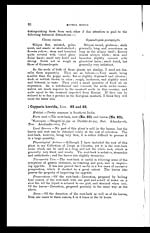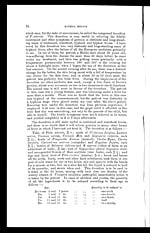Medicine - Drugs > Materia medica of Madras volume I > Vegetable kingdom
(49) Page 33
Download files
Individual page:
Thumbnail gallery: Grid view | List view

OF MADRAS.
33
European Drugs for which they may be substituted.—The root-bark
for Bismuthi subnitras and Acid. hydrocyanic. dil.; and the leaves for
Dill fruit.
Remarks.—The leaves of C. horrida are very frequently used as a
medicine by the natives of this country, but the root-bark is a much
better drug according to my own experience, as already mentioned.
VIOLACEÆ.
‡Viola odorata, Linn. 64.
Habitat.—Cultivated in gardens in some parts of India, partly as a
drug, and partly as an ornamental plant on account of its small and
beautiful blue or violet flowers.
Part Used.—The whole plant, including the root and flowers. The
best season for collecting this plant is when it is in flower.
Synonyms.—Sweet Violet, Eng. Banafshah, Pers., Hind. and Duk.
Banafshah, Arab. Banosá, Beng. Banaphsá, Guz.
Local Sources.—Sold in all the large bazaars of India. Generally
imported to Madras from Calcutta.
Price.—Wholesale, Rs. 14 per maund; retail or bazaar, As. 10 per
pound.
Physiological Actions.—Antipyretic and diaphoretic.
The, apeutic Uses.—Very useful in relieving febrile symptoms and
excitement in all forms of fever, as continued, remittent, typhoid, &c.,
particularly in combination with other drugs of the same nature, which
I shall speak of under the heading of "Remarks."
Preparations.— Compound and simple Decoctions. The compound
decoction of V. odorata with many other drugs will be described under
"Remarks." The simple decoction is prepared by boiling two ounces
and-a-half of the plant with one pint and-a-half of water, on a slow
fire, till the liquor is reduced to one pint, and strained. when cool.
Dose.—Of the simple decoction, from one to three fluid ounces.
European Drugs for which they may be substituted.—Warburg's
Tincture, Liq. ammon. acet. and Pulv. Jacobi vera.
Remarks.—The dry V. odorata sold in the bazaar is a very small
herb with thready branches; root small, fusiform, generally smooth,
and from 1 to 3 lines in thickness; stem short, often divided and
rough; leaves small, much shrivelled, but when moistened and spread
they are elliptical or oblong; flowers very small, grey or yellowish
white when old, and still retain their original blue or violet color when
new. The root of V. odorata is never sold separately in Southern India,
and it is so small that it will take several visses of the dry plant to get
an ounce of it. The correct Persian synonym for this root will be
Bikhe-banafshah, but according to a long-standing usage it is wrongly
applied in the bazaar to a much larger root, which is the produce of a
species of Iris, probably I. ensata or I. florentina.
If used alone, the action of V. odorata is not so satisfactory as
when it is employed together with other drugs of the same class. This
remark is applicable to every ingredient in the following prescription,
E
Set display mode to: Large image | Zoom image | Transcription
Images and transcriptions on this page, including medium image downloads, may be used under the Creative Commons Attribution 4.0 International Licence unless otherwise stated. ![]()
| India Papers > Medicine - Drugs > Materia medica of Madras volume I > Vegetable kingdom > (49) Page 33 |
|---|
| Permanent URL | https://digital.nls.uk/74907660 |
|---|




